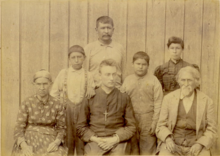Splitlog Church
It is named for Mathias and Eliza Splitlog, who built the church and founded Cayuga, which was an industrial center in the late 1880s.
It has a tall steeple above the front entrance with a Belfry (architecture) that held a 1,600 pound (726 kg) bronze bell[2] that was cast in Belgium, shipped to Neosho, Missouri, and then hauled by his son Henry Splitlog the 24 miles (39 km) from Neosho to Cayuga.
Limestone steps lead to the front entrance, which has plain wooden double doors, and has an arch adorned with fifteen Indian symbols.
Starting at the east end of the altar, each arched window has one letter of the designer's surname carved above it.
Thus, running down the right side of the nave, across the back, and returning up the left, the carvings form the name "Splitlog".
[3] In 1998, a 6-foot (1.8-meter) mural was discovered in the church; it depicts Delaware County, Oklahoma and is signed Victoria L. Morell, 1946.
[3][4] In the cornerstone was a copper can about the size of a cigar box, with pictures of Eliza and Mathias Splitlog, their biography, one of each of the coins used at that time, and some stamps.
[3] In 1892, Father Ketcham was a new priest working among the Quapaw and other tribes in the area, and Mathias asked to meet with him.
In 1893, Mathias Splitlog attended the pontifical mass when Reverend Theophile Meerschaert dedicated the new St. Mary's of the Quapaws 40 miles away, and was confirmed in the Catholic church then.
[4][9] Several of their grandchildren attended the Catholic Sacred Heart Academy in Vinita, Oklahoma, which Versavel established in 1897 while pastor there,[4] but some of the Splitlog children had marriages conducted by Jeremiah Hubbard, a Quaker missionary.
[4] Many of Splitlog's children died before him, and immediate issues about his estate were complicated by the laws at the time, and to a lesser extent the wishes of his heirs.
In 1906, US Senator Henry C. Hansbrough wrote into the Indian Appropriations Act of fiscal year 1908 that Splitlog's heirs could sell the church, cemetery, and the 3 acres of land to the Roman Catholic Church,[13] which allowed the bishop to buy it at a nominal fee.
[14] In 1953, the Methodists sold the church and cemetery land to the Sellers family, who had known the Splitlogs and didn't want to see the property decay.
His land holdings were in the community of Westport, which had become the starting point for numerous wagon trains headed west.
When the Civil War broke out, he enlisted in the Union Army and ferried materiel until he was captured by the Confederates.
[15] In 1863, the Union Pacific Railroad wanted to cross his land near the river and also build machine shops there.
[15] White settlers soon realized that the Wyandotte land was too valuable to let it remain in Native American hands and began pressuring the Government for their removal.
Initially, Matthias Splitlog stayed behind, but soon his friends began writing letters for him to join them in their new homeland.
He retained ownership of his home and the surrounding 12 acres (0.049 km2) in Kansas City until 1888, when he sold it to the Orchard Place Company.
His building projects employed many local people, paid good wages, and treated the employees well.
Destroyed structures included a hotel, general store, post office, blacksmith shop and eight or ten dwellings.
However, membership declined as Cayuga's residents moved away, and the Church found it very difficult to supply priests to serve this mission, so the parish was dissolved.
[11] In 1930, an individual person bought the church for sentimental reasons, agreeing to maintain the building and cemetery.

